Rapid Response for Perinatal Safety: Slide Presentation
AHRQ Safety Program for Perinatal Care
Slide 1: AHRQ Safety Program for Perinatal Care
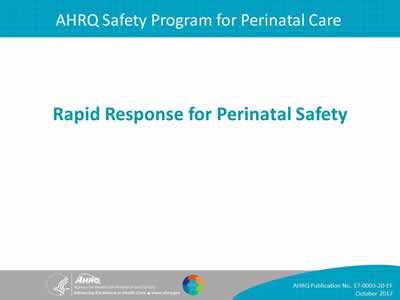
Rapid Response for Perinatal Safety
Slide 2: Learning Objectives
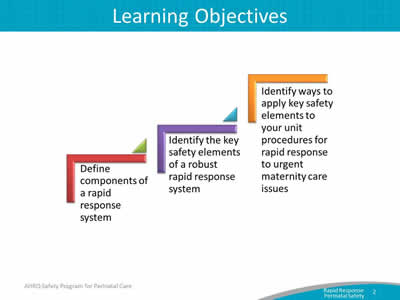
Image: Three ascending steps show the learning objectives:
- Define components of a rapid response system.
- Identify the key safety elements of a robust rapid response system.
- Identify tways to apply key safety elements to your unit procedures for rapid response to urgent maternity care.
Slide 3: Rapid Response
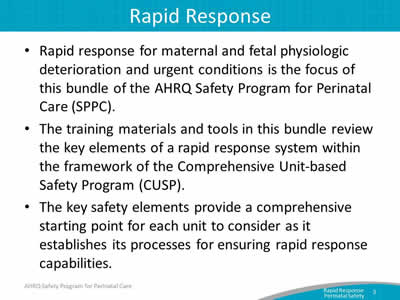
- Rapid response for maternal and fetal physiologic deterioration and urgent conditions is the focus of this bundle of the AHRQ Safety Program for Perinatal Care (SPPC).
- The training materials and tools in this bundle review the key elements of a rapid response system within the framework of the Comprehensive Unit-based Safety Program (CUSP).
- The key safety elements provide a comprehensive starting point for each unit to consider as it establishes its processes for ensuring rapid response capabilities.
Slide 4: Rapid Response System
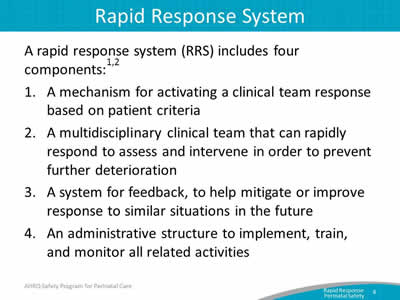
A rapid response system (RRS) includes four components:1,2
- A mechanism for activating a clinical team response based on patient criteria.
- A multidisciplinary clinical team that can rapidly respond to assess and intervene in order to prevent further deterioration.
- A system for feedback, to help mitigate or improve response to similar situations in the future.
- An administrative structure to implement, train, and monitor all related activities.
Slide 5: Obstetrical RRS
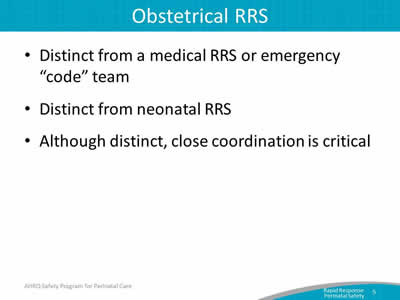
- Distinct from a medical RRS or emergency "code" team.
- Distinct from neonatal RRS.
- Although distinct, close coordination is critical.
Slide 6: Evidence for RRS
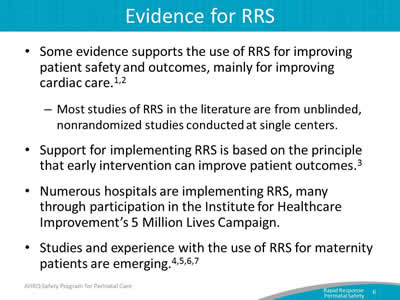
- Some evidence supports the use of RRS for improving patient safety and outcomes, mainly for improving cardiac care.1,2
- Most studies of RRS in the literature are from unblinded, nonrandomized studies conducted at single centers.
- Support for implementing RRS is based on the principle that early intervention can improve patient outcomes.3
- Numerous hospitals are implementing RRS, many through participation in the Institute for Healthcare Improvement’s 5 Million Lives Campaign.
- Studies and experience with the use of RRS for maternity patients are emerging.4,5,6,7
Slide 7: RRS Tool
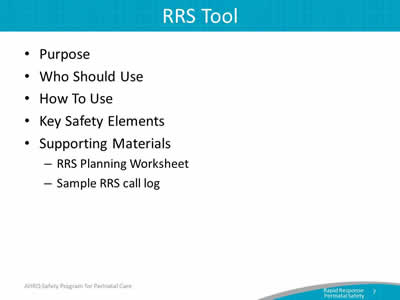
- Purpose.
- Who Should Use.
- How To Use.
- Key Safety Elements.
- Supporting Materials:
- RRS Planning Worksheet.
- Sample RRS call log.
Slide 8: SPPC Key Perinatal Safety Elements for RRS
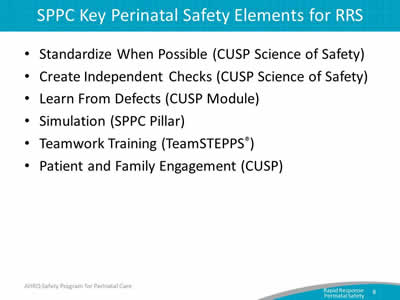
- Standardize When Possible (CUSP Science of Safety).
- Create Independent Checks (CUSP Science of Safety).
- Learn From Defects (CUSP Module).
- Simulation (SPPC Pillar).
- Teamwork Training (TeamSTEPPS®).
- Patient and Family Engagement (CUSP).
Slide 9: Key Safety Elements: Standardize When Possible
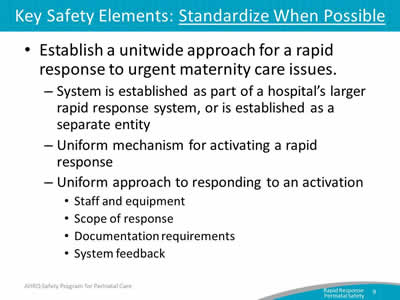
- Establish a unitwide approach for a rapid response to urgent maternity care issues.
- System is established as part of a hospital’s larger rapid response system, or is established as a separate entity.
- Uniform mechanism for activating a rapid response.
- Uniform approach to responding to an activation:
- Staff and equipment.
- Scope of response.
- Documentation requirements.
- System feedback.
Slide 10: Key Safety Elements: Standardize When Possible
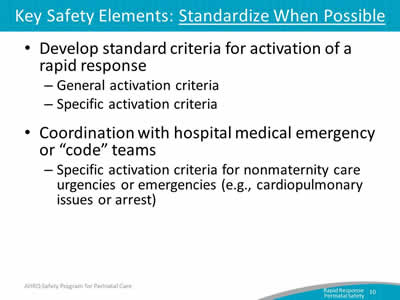
- Develop standard criteria for activation of a rapid response:
- General activation criteria.
- Specific activation criteria.
- Coordination with hospital medical emergency or "code" teams:
- Specific activation criteria for nonmaternity care urgencies or emergencies (e.g., cardiopulmonary issues or arrest).
Slide 11: Key Safety Elements: Standardize When Possible
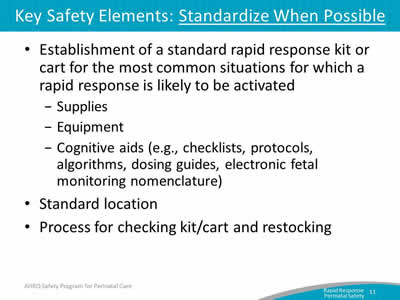
- Establishment of a standard rapid response kit or cart for the most common situations for which a rapid response is likely to be activated:
- Supplies.
- Equipment.
- Cognitive aids (e.g., checklists, protocols, algorithms, dosing guides, electronic fetal monitoring nomenclature).
- Standard location.
- Process for checking kit/cart and restocking.
Slide 12: Key Safety Elements: Create Independent Checks
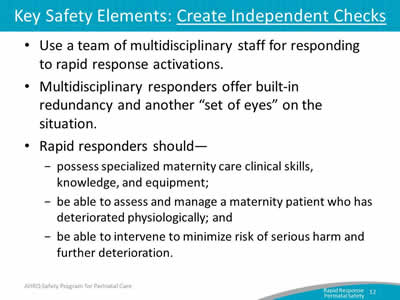
- Use a team of multidisciplinary staff for responding to rapid response activations.
- Multidisciplinary responders offer built-in redundancy and another "set of eyes" on the situation.
- Rapid responders should—
- Possess specialized maternity care clinical skills, knowledge, and equipment.
- Be able to assess and manage a maternity patient who has deteriorated physiologically.
- Be able to intervene to minimize risk of serious harm and further deterioration.
Slide 13: Key Safety Elements: Create Independent Checks
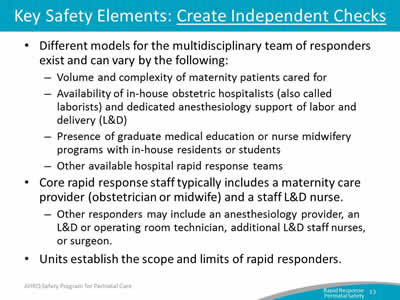
- Different models for the multidisciplinary team of responders exist and can vary by the following:
- Volume and complexity of maternity patients cared for.
- Availability of in-house obstetric hospitalists (also called laborists) and dedicated anesthesiology support of labor and delivery (L&D).
- Presence of graduate medical education or nurse midwifery programs with in-house residents or students.
- Other available hospital rapid response teams.
- Core rapid response staff typically includes a maternity care provider (obstetrician or midwife) and a staff L&D nurse.
- Other responders may include an anesthesiology provider, an L&D or operating room technician, additional L&D staff nurses, or surgeon.
- Units establish the scope and limits of rapid responders.
Slide 14: Key Safety Elements: Learn From Defects
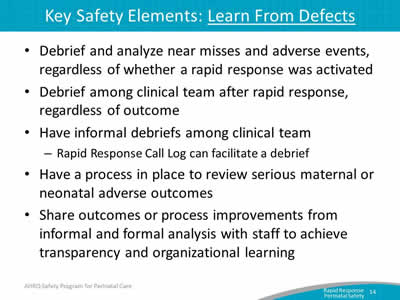
- Debrief and analyze near misses and adverse events, regardless of whether a rapid response was activated.
- Debrief among clinical team after rapid response, regardless of outcome.
- Have informal debriefs among clinical team.
- Rapid Response Call Log can facilitate a debrief.
- Have a process in place to review serious maternal or neonatal adverse outcomes.
- Share outcomes or process improvements from informal and formal analysis with staff to achieve transparency and organizational learning.
Slide 15: Key Safety Elements: Simulation
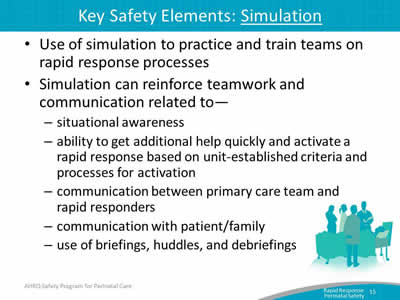
- Use of simulation to practice and train teams on rapid response processes.
- Simulation can reinforce teamwork and communication related to—
- Situational awareness.
- Ability to get additional help quickly and activate a rapid response based on unit-established criteria and processes for activation.
- Communication between primary care team and rapid responders.
- Communication with patient/family.
- Use of briefings, huddles, and debriefings.
Slide 16: Key Safety Elements: Teamwork Training
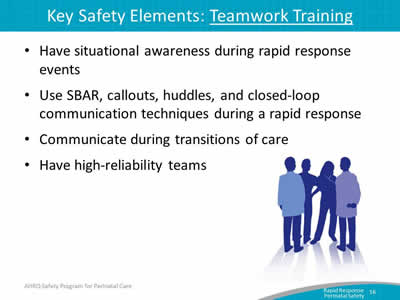
- Have situational awareness during rapid response events.
- Use SBAR, callouts, huddles, and closed-loop communication techniques during a rapid response.
- Communicate during transitions of care.
- Have high-reliability teams.
Slide 17: Key Safety Elements: Teamwork Training
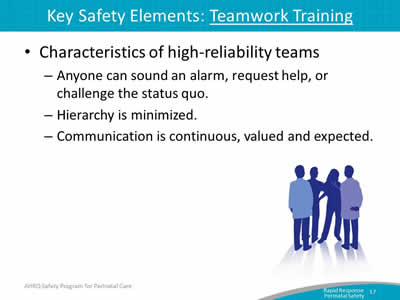
- Characteristics of high-reliability teams:
- Anyone can sound an alarm, request help, or challenge the status quo.
- Hierarchy is minimized.
- Communication is continuous, valued and expected.
Slide 18: Key Safety Elements: Patient and Family Engagement
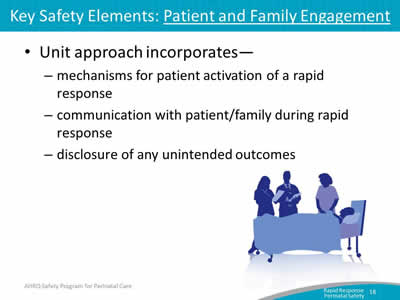
- Unit approach incorporates—
- Mechanisms for patient activation of a rapid response.
- Communication with patient/family during rapid response.
- Disclosure of any unintended outcomes.
Slide 19: Unit Next Steps
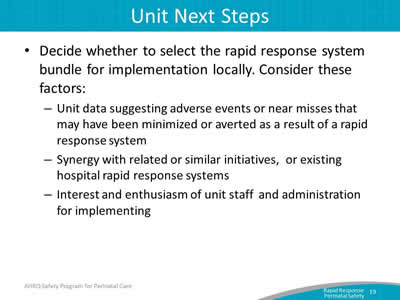
- Decide whether to select the rapid response system bundle for implementation locally. Consider these factors:
- Unit data suggesting adverse events or near misses that may have been minimized or averted as a result of a rapid response system.
- Synergy with related or similar initiatives, or existing hospital rapid response systems.
- Interest and enthusiasm of unit staff and administration for implementing.
Slide 20: Unit Next Steps
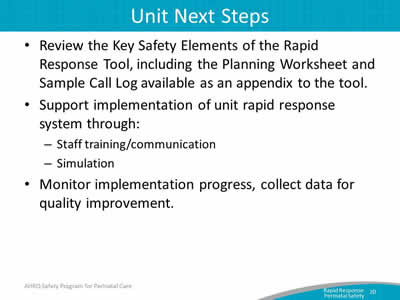
- Review the Key Safety Elements of the Rapid Response Tool, including the Planning Worksheet and Sample Call Log available as an appendix to the tool.
- Support implementation of unit rapid response system through:
- Staff training/communication.
- Simulation.
- Monitor implementation progress, collect data for quality improvement.
Slide 21: Tips for Implementation Success
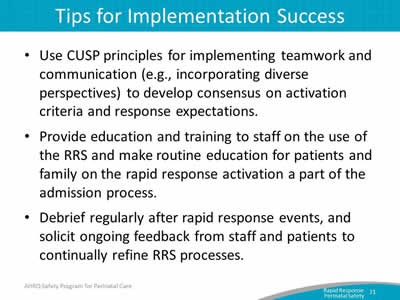
- Use CUSP principles for implementing teamwork and communication (e.g., incorporating diverse perspectives) to develop consensus on activation criteria and response expectations.
- Provide education and training to staff on the use of the RRS and make routine education for patients and family on the rapid response activation a part of the admission process.
- Debrief regularly after rapid response events, and solicit ongoing feedback from staff and patients to continually refine RRS processes.
Slide 22: References
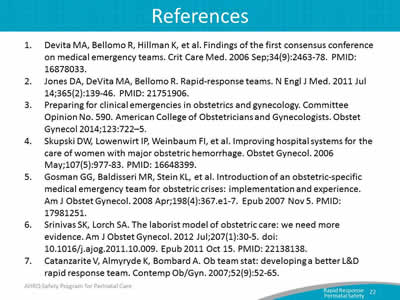
- Devita MA, Bellomo R, Hillman K, et al. Findings of the first consensus conference on medical emergency teams. Crit Care Med 2006 Sep;34(9):2463-78. PMID: 16878033.
- Jones DA, DeVita MA, Bellomo R. Rapid-response teams. N Engl J Med 2011 Jul 14;365(2):139-46. PMID: 21751906.
- Preparing for clinical emergencies in obstetrics and gynecology. Committee Opinion No. 590. American College of Obstetricians and Gynecologists. Obstet Gynecol 2014;123:722–5.
- Skupski DW, Lowenwirt IP, Weinbaum FI, et al. Improving hospital systems for the care of women with major obstetric hemorrhage. Obstet Gynecol 2006 May;107(5):977-83. PMID: 16648399.
- Gosman GG, Baldisseri MR, Stein KL, et al. Introduction of an obstetric-specific medical emergency team for obstetric crises: implementation and experience. Am J Obstet Gynecol 2008 Apr;198(4):367.e1-7. Epub 2007 Nov 5. PMID: 17981251.
- Srinivas SK, Lorch SA. The laborist model of obstetric care: we need more evidence. Am J Obstet Gynecol 2012 Jul;207(1):30-5. doi: 10.1016/j.ajog.2011.10.009. Epub 2011 Oct 15. PMID: 22138138.
- Catanzarite V, Almyryde K, Bombard A. Ob team stat: developing a better L&D rapid response team. Contemp Ob/Gyn 2007;52(9):52-65.
Slide 23: Disclaimer
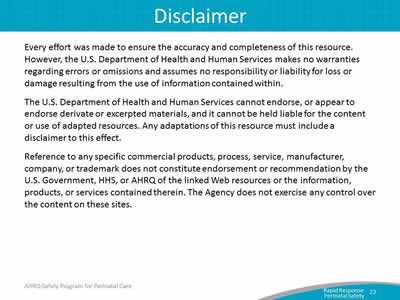
Every effort was made to ensure the accuracy and completeness of this resource. However, the U.S. Department of Health and Human Services makes no warranties regarding errors or omissions and assumes no responsibility or liability for loss or damage resulting from the use of information contained within.
The U.S. Department of Health and Human Services cannot endorse, or appear to endorse derivate or excerpted materials, and it cannot be held liable for the content or use of adapted resources. Any adaptations of this resource must include a disclaimer to this effect.
Reference to any specific commercial products, process, service, manufacturer, company, or trademark does not constitute endorsement or recommendation by the U.S. Government, HHS, or AHRQ of the linked Web resources or the information, products, or services contained therein. The Agency does not exercise any control over the content on these sites.



